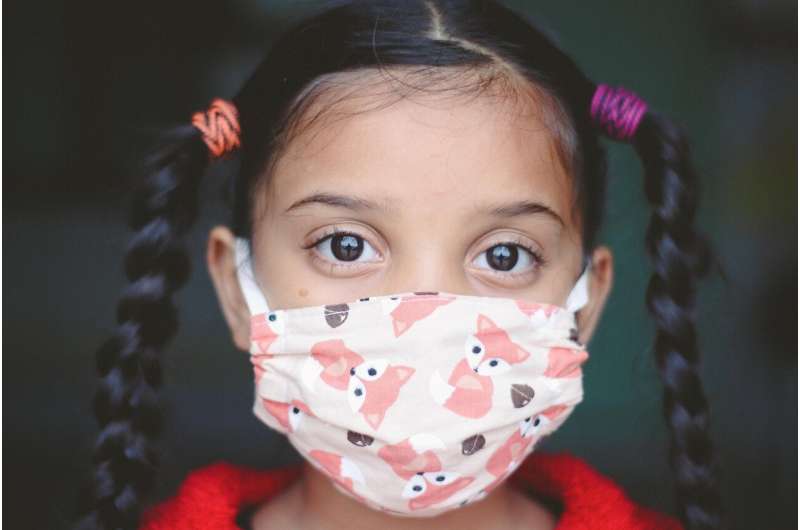This article has been reviewed according to Science X's editorial process and policies. Editors have highlighted the following attributes while ensuring the content's credibility:
fact-checked
peer-reviewed publication
trusted source
proofread
Researchers publish comprehensive report on long COVID symptoms in children

Up to 5.8 million children and youth in the U.S. have experienced symptoms of COVID-19 that persisted long after initial infection. But diagnosing pediatric post-acute sequelae of SARS-CoV-2 (PASC)—known as long COVID—in children remains challenging, as it can affect any organ system in the body, symptoms vary widely by individual, and little is known about its trajectory in patients over time.
Children's Hospital Los Angeles is one of 10 pediatric sites involved in the nationwide Researching COVID to Enhance Recovery (RECOVER) Initiative, sponsored by the National Institutes of Health to improve the diagnosis, treatment, and prevention of long-term COVID-19 in children. CHLA researchers and their collaborators in the RECOVER Initiative have published a comprehensive report on pediatric long COVID symptoms in the journal Pediatrics.
"At our Long COVID Recovery Care clinic, some patients have symptoms for two months and there are others whose symptoms have still not gone away two years later," says Sindhu Mohandas, MD, co-Director, Immunocompromised Infectious Diseases Program at Children's Hospital Los Angeles and study co-author.
"But we still don't know which patients are at risk for long-term symptoms. Until this report, doctors looking for information could only refer to small, case-based studies. Pediatric clinicians and researchers can now use this paper to quickly access the latest research on long COVID in children and reference the source studies," Dr. Mohandas continues.
Summarizing the research
The RECOVER collaborators across the country reviewed existing research on long-term COVID-19 in kids in their respective areas of expertise, including its epidemiology, risk factors, clinical characteristics, and outcomes. "Our goal was to summarize all available knowledge from those smaller articles, case reports, and clinic-based studies on the full range of long COVID symptoms that we are seeing across the U.S.," says Dr. Mohandas.
Their findings have so far uncovered a few clues to long COVID risk. For instance, about 45% of the children who developed long COVID experienced COVID-19 symptoms rather than symptomless infections (15%). Other factors include older age, more severe initial COVID-19 infection, the number of different organ systems initially affected, underlying medical conditions, and higher weight.
The most common long-term COVID symptoms in children involve fatigue, persistent headaches, weakness, musculoskeletal pain, shortness of breath, loss of taste and smell, and dizziness. Between 2% to 44% of kids with long-term COVID-19 can experience difficulties in concentration—known as brain fog—after physical or mental effort. Brain fog/fatigue can also mimic the symptoms of myalgic encephalomyelitis—known as chronic fatigue syndrome. This can last for at least six months and impair daily function.
Long COVID is linked with the new onset of type 1 or type 2 diabetes about a month after initial infection. Long COVID is also associated with the development of multisystem inflammatory syndrome in children (MIS-C)—thought to be caused by abnormally high activation of the immune response—involving heart damage, irregular heart rhythms, and conduction abnormalities.
"Most MIS-C symptoms disappear after six months, but a minority of children still experience unexplained exercise intolerance and fatigue," says John C. Wood, MD, Ph.D., cardiologist and investigator at CHLA, and study co-author.
Pediatricians are under-diagnosing long COVID, Dr. Wood adds. "Some believe children don't get long COVID, and others just don't know the signs and symptoms. I think the big 'added value' to this published study is that it provides some of the characteristic 'fingerprints' that pediatricians can use to recognize long COVID."
Worsening pre-existing conditions
Long COVID can aggravate chronic respiratory conditions such as asthma. Several studies showed that while asthma didn't worsen during the initial COVID-19 infection, it did so during the six months after infection.
Long COVID can also worsen rare fibromyalgia and connective tissue disorders such as Ehlers-Danlos syndrome or Marfan syndrome. These conditions are also linked with chronic fatigue syndrome and the dysregulation of involuntary body functions such as blood pressure and heart rate, causing dizziness when shifting position or standing, a condition like postural orthostatic tachycardia syndrome (POTS).
"We needed to follow a large group of kids over a long span of time to see the prevalence and clinical course of some of these rare symptoms," says David Warburton, MD, stem cell researcher and neonatologist at CHLA.
"Our hope is that this effort to better understand long COVID can lead to a deeper understanding of these other conditions as well—and to effective treatments. We are now collecting information on symptoms that re-emerge over time during periods of physical and/or psychological stress and re-infection to learn how to prevent chronic conditions from emerging in adulthood."
More information: Suchitra Rao et al, Postacute Sequelae of SARS-CoV-2 in Children, Pediatrics (2024). DOI: 10.1542/peds.2023-062570


















